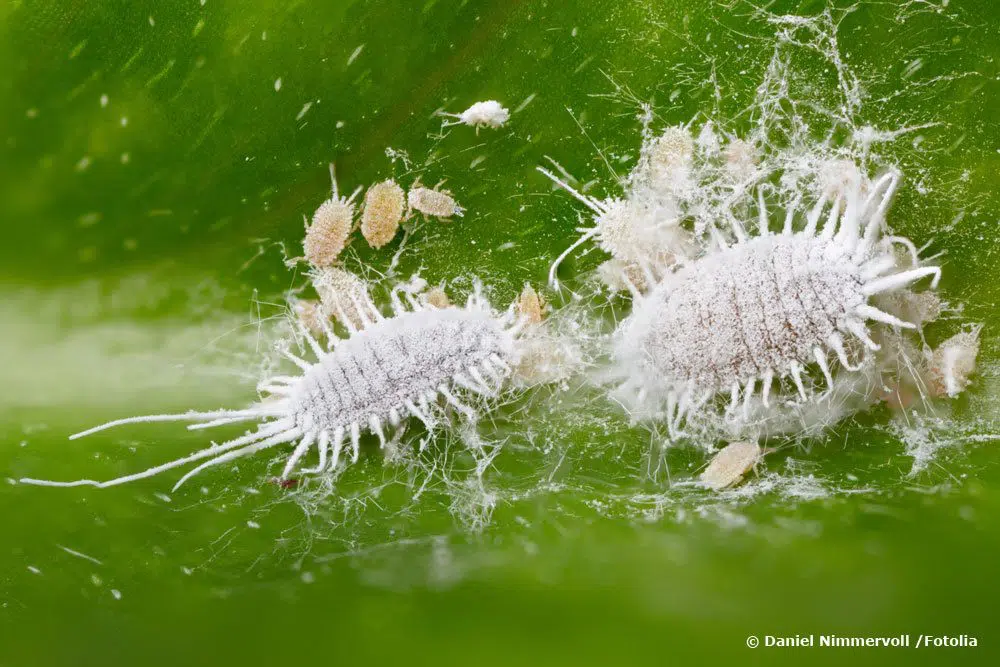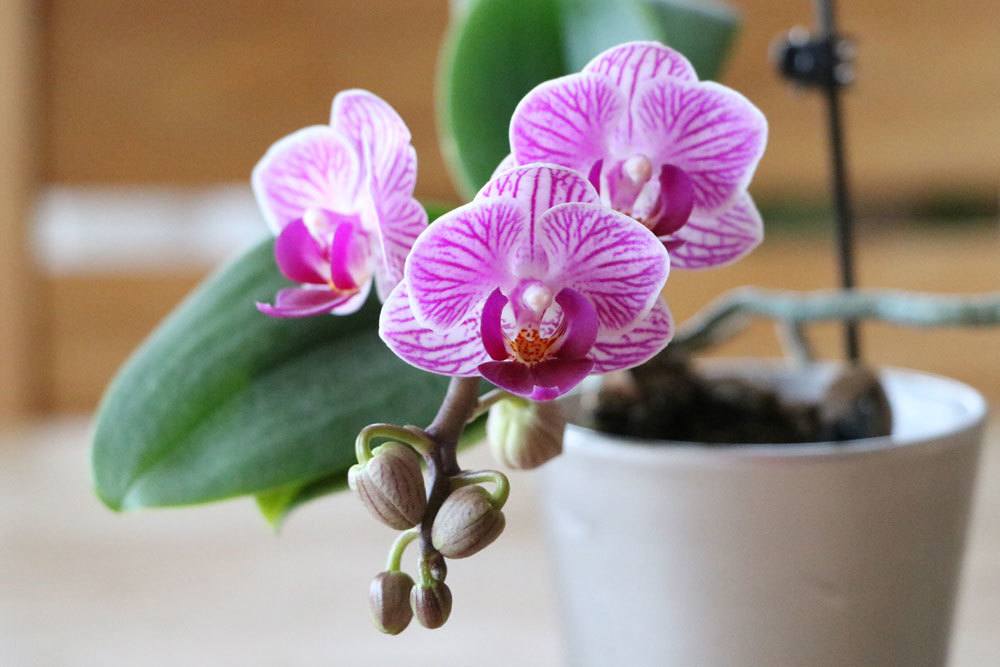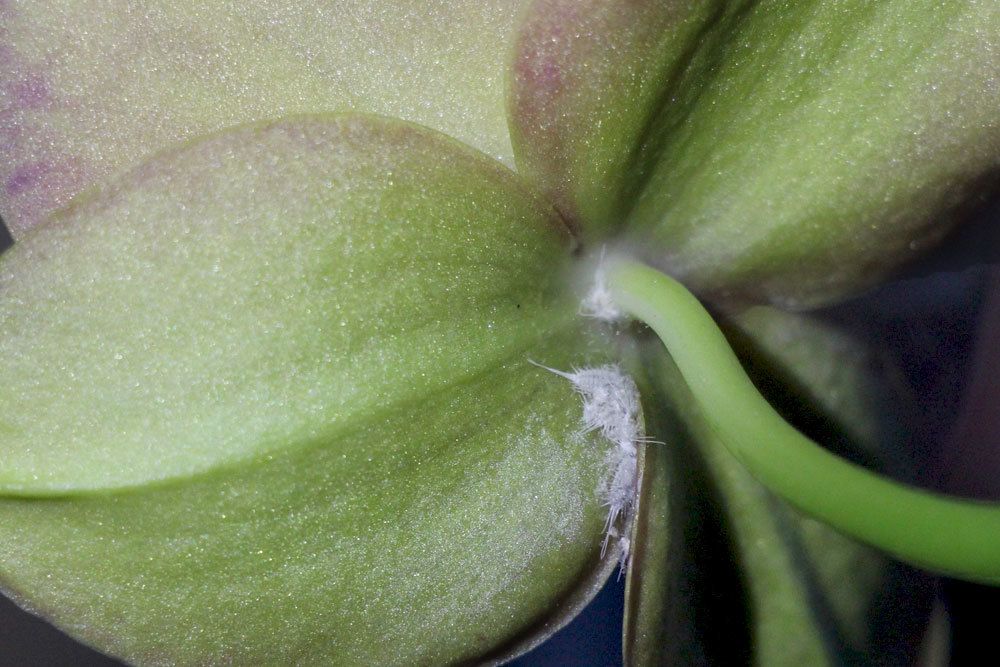When the buds of an orchid open, filigree flowers emerge in the most brilliant colors. As if sculpted by an artist for eternity. And indeed, each flower stalk delights us for several weeks at a time. Unfortunately, orchids are not only popular with us humans. Woolly aphids also appreciate these delicacies. They suck diligently from the plant sap until there is nothing left of it. Is there a gentle way to effectively combat them?
Contents
- 1 Do mealybugs need to be targeted?
- 2 How can you recognize a mealybug infestation?
- 3 Where do mealybugs come from anyway?
- 4 Get rid of mealybugs
- 5 Home remedies or chemicals?
- 6 Water washes away the mealybugs
- 7 Alcohol attacks adult mealybugs
- 8 Solutions with soft soap
- 9 Canola oil-water emulsion
- 10 Neem oil stops the development of larvae
- 11 Predators as hard-working helpers
- 12 Author
Do mealybugs need to be targeted?
First of all, the mealybug is known by different names:
- actual name is smear louse
- because of the woolly hair it is called mealybug
- it is a species of scale insect
- scale, mealybug or mealybug: three names, one pest
Spittlebugs have developed sucking on plants to perfection. It doesn’t take long before all the plant sap has flowed. It’s the mass that does it, because the more mealybugs get at the orchid, the faster they complete their destructive work. The only solution is to fight the explosive multiplication of these pests and get rid of the already existing specimens as soon as possible. Then, and only then, orchids can still be saved. They are weakened, but with time and proper care they recover.

How can you recognize a mealybug infestation?
If a mealybug cannot be overlooked when casually looking at the orchids, it is usually already too late. These pests must be detected and recognized much earlier for control measures to have any chance of success. Scale insects leave behind visible tracks that need to be read.
- small white cotton balls on and under the leaves
- delicate white webs appear in the leaf axils
- budding of buds and leaves looks crippled
- brownish spots
- premature wilting of leaves and flowers
- sticky leaves from excreted honeydew
- sooty fungi like the honeydew
- recognizable by black discoloration of the leaves
Where do mealybugs come from anyway?
Mealybugs often come as uninvited companions of a newly bought plant into our living rooms or into the garden. They continue to multiply there and weaken the infested plant more and more. But that’s not all, they soon discover the healthy plants in the neighborhood. You have to fight them as soon as possible, otherwise they will infest and destroy one plant after another. In particular, low-light locations, dry and warm heating air, as well as incorrect fertilization make the orchids inviting tidbits for the mealybugs, which feel particularly comfortable under these conditions and multiply accordingly diligently.
Get rid of mealybugs
Quarantine: the first sensible step
Whether only the signs of the infestation are visible, or already the mealybug can be seen with the naked eye on the orchids, the infested plant must be immediately isolated from healthy plants. This eliminates the high risk of infection. At their new location, the actual fighting can then begin.
Home remedies or chemicals?
In the early stages of infestation, mealybugs can be effectively controlled with many home remedies. A home remedy is more environmentally friendly than a chemical insecticide and should be used as a priority. Home remedies are also gentler on orchids when used properly and are usually much less expensive than insecticides. However, the labor involved is also greater than with a chemical remedy. Labor savings would also be the only reason to reach for the chemical bottle right away. If the infestation is far advanced, the home remedies hardly help. But neither will chemistry.
If the orchid can no longer be saved, it should be disposed of immediately in the residual waste.
Water washes away the mealybugs
The most inexpensive and harmless to orchids method is to rinse away the aphids with the hard water jet. In order not to put the orchid under water, you should do it as follows
- wrap the pot of the infested orchid watertight in a plastic bag
- Rinse free parts of the plant with lukewarm tap water. The more hard-leaved the orchid variety, the harder the water jet it can tolerate.
- turn the orchid upside down and rinse again thoroughly
- dab the leaves with a soft cloth, so that no lime stains form after drying
- then remove the plastic bag from the orchid pot
This home remedy is especially effective against the young brood of the pests. Adult mealybugs coat themselves with a protective layer of wax, to which water beads off well. They have also taken hold of the plant, so that even a hard water jet misses its effect. So do not stop at this measure, alone it is not enough to completely combat the mealybugs.
Tip: If your tap water has a high lime content, it is better to use a pressure sprayer with decalcified tap water or rainwater.
Alcohol attacks adult mealybugs
Alcohol solutions have active ingredients that can dissolve the wax layer of mealybugs. Without this layer, the alcohol acts even further and also damages the “exposed” mealybugs.
- Moisten cloth with alcohol and wipe all leaves with it
- Do not forget the undersides
- hard to reach places should not be left out
- cotton swabs dipped in alcohol are helpful here
- repeat application every 2-3 days
- until all symptoms are gone
Butterfly orchids have robust leaves and survive multiple alcohol baths well. However, other hard-leaved species are also predestined for this home remedy. Orchids with softer leaves, on the other hand, should be treated with caution. If there are doubts whether they will survive the procedure well, it is better to switch to another home remedy.

Solutions with soft soap
Scientific studies show that soft soap solutions are more effective against mealybugs than many an insecticide. But unlike chemistry, this remedy does not pose any health risks to the user.
- dissolve about 30 grams of curd or soft soap in one liter of water (warm, decalcified water is best)
- add a few squirts of spirit
- pour cooled mixture into a hand spray bottle
- spray orchid thoroughly, do not leave out any spot
- put a transparent plastic bag over the orchid and close it tightly, lack of fresh air increases the effect of the soap solution
Repeat the treatment every 2-3 days until you are sure that there are no more mealybugs alive.
spray again after 14 days, because the eggs of these pests are not destroyed by the soap solution, and new mealybugs can hatch.
Tip: Curd soap finely grated with a household grater dissolves more easily in water. Depending on the type of soap, the consistency of the solution may be too thick to spray. Simply add a little warm water to dilute.
Canola oil-water emulsion
Envelop the pesky pests in a mist of canola oil and water in a 7:3 ratio. There is no escape for the mealybugs from this. Here’s what you should consider when combating them:
- Add 1-percent soft soap solution as an emulsifier.
- treat only hard-leaved orchids with it
- spray the upper and lower sides of the leaves
- sunlight is unfavorable
- therefore spray in the evening
- place the orchid in a shady place
- Do not spray canola oil solution more than 3 times.
Tip: Instead of rapeseed oil, kerosene oil can also be used. The ideal composition is 12 grams per liter of water.

Neem oil stops the development of larvae
The oil is pressed from seeds of the neem tree and is a purely natural agent. Nevertheless, special care should be taken when handling it, because direct skin contact can cause allergic reactions. The oil can be purchased in specialized stores. When using it, follow the manufacturer’s instructions. Remain consistent in its application so that the reproduction cycle of mealybugs is effectively interrupted.
Ecological means from the trade
Meanwhile, those who do not have time to prepare their own spray solutions can discover some ecological remedies against mealybugs in stores. For these also contain home remedies such as rapeseed oil, soft soap and Co. Get advice on which of these is best for you.
Predators as hard-working helpers
Parasitic wasps, ladybugs and lacewing larvae are not welcome guests in living spaces. Yet these beneficial insects fight mealybugs whenever any cross their path. However, if the orchids thrive in a greenhouse, this type of biological control is well worth considering. On the Internet you can find some supply addresses for these industrious helpers.










